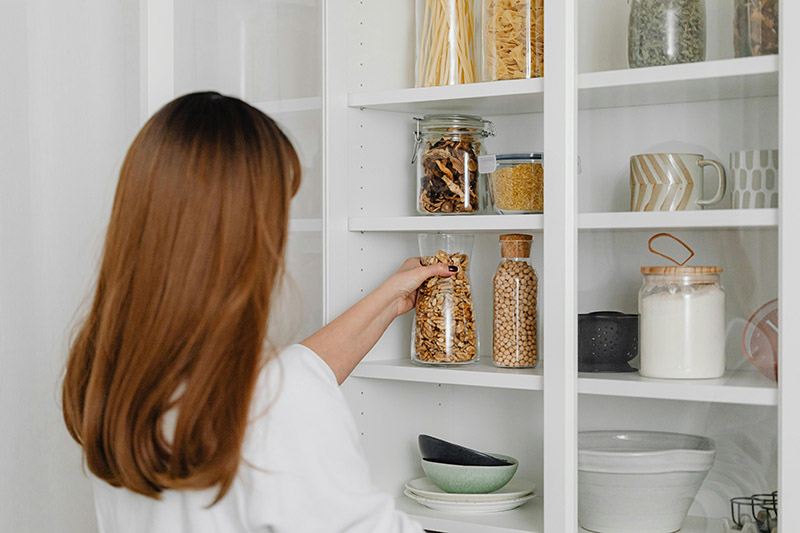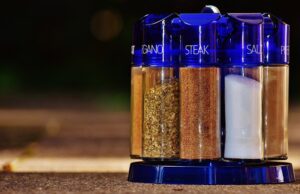
Aspirational pantry pics on social media may have you rushing off to buy a 50-pack of matching canisters. Everything from pasta to spices will look great in those beautiful vessels, right?
I know purchasing gives us a dopamine hit, but before you load up your shopping cart, think about the negatives of decanting and whether you can cope with them.
Decanting your pantry food into canisters – Cons
1. You should allow each canister to empty before you wash it out, let it dry and then refill. (Requires effort) Otherwise you are putting new food on top of older food, which is a bad strategy.
2. You need somewhere to store the refills, which we will call backstock. (Requires space) Maybe it’s behind the canister, or in a separate backstock shelf where all your refills go. Will you remember that they exist and where they are? (Requires effort)
3. Your canisters are almost never full, in fact some may be nearly empty – which means you are storing air, as well as the backstock in waiting. (Requires space) Do you have a big enough pantry for that?
4. You won’t know what is in the canisters, how to cook it or what the useby dates are unless you label them. (Requires effort) The packaging you have thrown in the bin contained lots of useful information you can no longer access.
5. Canisters require buying more stuff and more plastic. I remember an episode of The Home Edit where they dumped a box of individually wrapped ice creams out of their box into a plastic container which went in the freezer. Just … why?
6. You need somewhere to store surplus unused canisters. Alternatively you run out of canisters and have to buy more at inconvenient times – and run the risk that your chosen model has been discontinued.
7. It’s messy. Especially things like oils and vinegars. How do you even wash those bottles? Your kitchen is not an apothecary shop.
As a professional organiser working in pantries, I have dumped the contents of countless canisters into rubbish bins – with full consent and agreement from the owner of course. Why? The canisters have been languishing for an unspecified period with unspecified foodstuffs and unspecified useby dates. Seemed like a great idea at the time, but the mystery items are wasted.
However it’s not all bad.
Decanting your pantry food into canisters – Pros
1. Canisters keep out pantry moths and mice. This is important. But remember you can put whole packets into canisters/containers if you have a pest problem – you don’t have to decant. Also please know that there may be insect eggs in your food staples (namely grains and flours) when you buy them, and if you keep them long enough they will hatch in the pack OR the canister. And anyway, in the meantime the pests are probably nibbling away at your backstock.
2. Canisters maintain freshness. I cannot argue with this. But a good roll and fold packet-closure or chip-clip can be equivalent. Foldback/bulldog clips work well too.
2. It looks amazing. It’s a streamlined, consistent aesthetic without the visual noise of packets competing for attention.
3. You can quickly see what you have. Although you can’t necessarily see your backstock, nor do you have the recognisability of branding, so this may be a moot point.
4. It may be easier to Tetris your staples. Stackable containers can maximise space. But I do feel this is countered by Cons – tip 3. You are inevitably storing lots of air.
5. For the completely organised and sustainably-minded domestic god/dess, re-using glass jars and taking them to bulk shops like The Source and cutting out plastic packaging altogether is totally respected. There should be more of this.
6. In general the practice is okay if you have enough space, energy and money to implement and maintain. The Kardashians definitely have it covered.
But it’s certainly not a compulsory aspect of an organised kitchen, and doesn’t suit all households or products.
Remember that it’s not all or nothing. Decanting your pantry food into canisters can suit some high-turnover products that you churn through, especially if the packaging is flimsy and makes access messy or difficult.
Some people prefer to decant low-turnover goods because they get more time in the canister, making it more worthwhile. But in that case labelling is crucial. If you don’t want to handwrite you can cut off relevant parts of the pack and stick them on the canister, or even pop them in. Pest-prone homes and items may also deserve canisters.
I previously chatted about decanting your pantry food into canisters in this article, and if you want another voice, this is a great take.






























